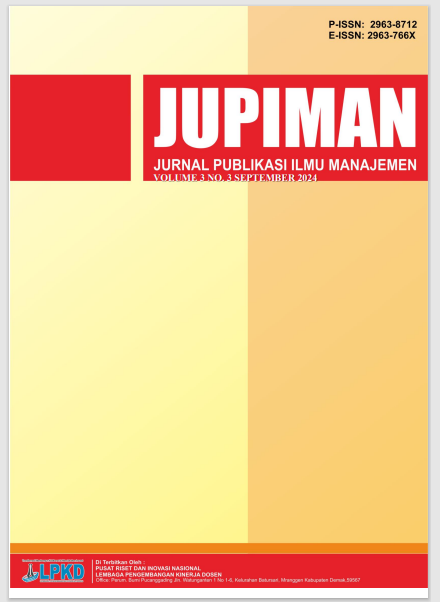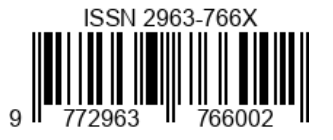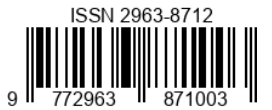Analisis Dampak Pengguna Sosial Media Terhadap Produktivitas Akademik Mahasiswa
DOI:
https://doi.org/10.55606/jupiman.v4i1.4828Keywords:
Impact, Social Media, Users, ProductivityAbstract
This research was conducted with the aim of finding out the impact of social media use on student academic productivity and how to overcome dependence. This type of research is a qualitative research with an interview method. With a data collection technique carried out through direct conversations between researchers and respondents, the purpose of this interview is to obtain deeper and more detailed information. The most widely used social media are whatsapp, Instagram, tiktok, youtobe, facebook, blogger and twitter. Students tend to get bored when they don't use social media because each social media has advantages that make its users. The intensity of social media use averages more than 4 hours a day and the medium used to access the social media is a smartphone. The impact of social media students use social media to get information about knowledge, tips and tricks for learning that make it easier to do assignments so as to support their achievements. The way students can overcome learning dependence on social media is by managing or managing time well, limiting the use of social media, increasing activities outside so that they minimize opening social media, by turning off notifications so that they can focus on doing assignments or other things that are being done.Downloads
References
Abrar, A N. (2003). Teknologi Komunikasi Perpektif Ilmu Komunikasi. LESFI.
Aillerie, Karine dan Sarah McNicol. (2016). “Information literacy and social networking sites: challenges and stakes regarding teenagers’ uses” dalam ESSACHESS. Journal for Communication Studies, vol. 9, no. 2(18) / 2016: 89-100
Alciano, G. (2015). Pengaruh Media Sosial Terhadap Perkembangan Anak dan Remaja. Jurnal Mitra Manajement. Vol 7, No2, Hal 38-39.
Baidu, et al. (2014). Jelajah Mobile di Indonesia. Baidu Indonesia.
Istiani, N., & Islamy, A. (2020). Fikih Media Sosial di Indonesia. Asy Syar’Iyyah: Jurnal Imu Syari’Ah dan Perbankan Islam, 5(2), 202 225.https://doi.org/10.32923.v5i2.1 586
Kotler, P. (2002). Manajemen Pemasaran (Milenium). Prehalindo.s.
Kuss, D,J.,Griffiths, M.D., & Binder (2013), Internet Addiction in Students: Preva;ence and Risk Factors. Computers in Human Behavior, 29(3), 959-966.
Machali, Imam. (2021). Metode Penelitian Kuantitatif : Panduan Praktis Merencanakan, Melaksanakan dan Analisis dalam Penelitian Kuantitatif. Yogyakarta : UIN Sunann Kalijaga Yogyakarta.
Mukhtar. (2013). Metode Praktid Penelitian Deskriptif Kualitatif. Refrensi (GP Pres Group)
Nasrullah, R. (2015). Media Sosial: Perspektif Komunikasi, Budaya dan Sosio teknologi, Simbiosa Rekatama Media.
Prakoso, Septyanto Galan, Monika Sri Yuliarti, and Likha Sari Anggreni. (2017). “The Importance of Social Media Literacy for Students in Globalization Age” dalam The International Conference on Design and Technology, KnE Social Sciences, 191–197. DOI 10.18502/kss.v2i4.886.
Psikologi Teori dan Terapan, 102-106.Hhtps://doxplayer.info/67563592-Perbedaanperilaku-konsumtif- ditinjau-dari-tipe-kepribadian-pada- siswa-sekolahmenengah-atas.html
Riduwan. (2010). Skala Pengukuran Variabel-variabel Penelitian: Alfabeta Rook, D.W (1987). “The Buying Impulse. “Journal of Consumer Research, 14, 189 199.
Rook, D.W (1987). “The Buying Impulse. “Journal of Consumer Research, 14, 189 199.
Siregar, Syofian. (2014). Statistic Parametric Untuk Penelitian Kuantitatif. Jakarta: vBumi Aksara.
Widyaningrum, D., & Puspitadewi, N. (2016). Perbedaan Perilaku Konsumtif Ditinjau dari Tipe Kepribadian pada Siswa Sekolah Menengah Atas. Psikologi Teori dan Terapan, 102-106. Hhtps://doxplayer.info/67563592- Perbedaanperilaku-konsumtif- ditinjau- dari-tipe-kepribadian-pada- siswa sekolahmenengah-atas.html
Downloads
Published
How to Cite
Issue
Section
License
Copyright (c) 2025 Jurnal Publikasi Ilmu Manajemen

This work is licensed under a Creative Commons Attribution-ShareAlike 4.0 International License.








